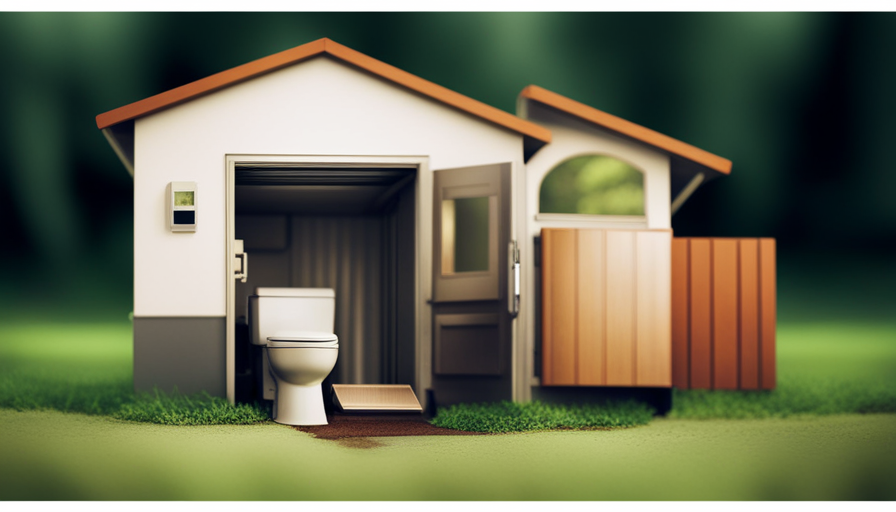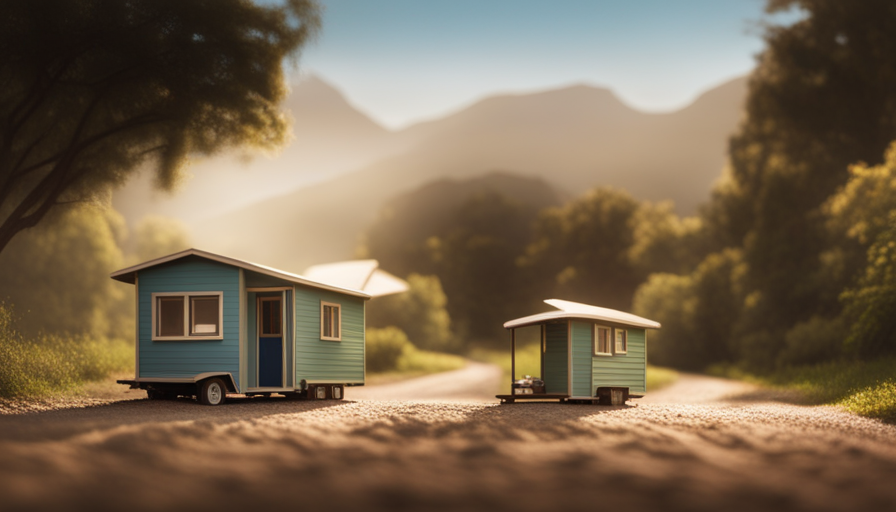They say good things come in small packages. Have you ever thought about how small your dream home can legally be? Let’s dive into zoning laws and construction regulations to uncover the secrets of creating the tiniest, coolest tiny house of your dreams. Find out just how small you can go legally! Keep reading to unlock the mysteries of tiny house living.
From understanding the factors that determine size limitations, to differentiating between on-wheels and foundation-based structures, we will leave no stone unturned.
Navigating the legal requirements for road travel and considering accessibility and safety regulations are also crucial aspects we will explore.
Additionally, we will discuss alternative options for those seeking a bigger tiny house, as well as the potential consequences of non-compliance.
Through case studies and examples, we will provide real-world insights into legal tiny house lengths.
Join me on this informative journey to find the perfect balance between size and legal compliance for your tiny house dreams.
Key Takeaways
- Zoning laws and building codes vary by location and can affect the maximum length of a tiny house.
- On-wheels and foundation-based tiny houses have different regulations and must comply with specific zoning and building code restrictions.
- Permits are required to legally transport a tiny house, and size restrictions for road transport include length, width, and height.
- Non-compliance with zoning laws and building codes can result in fines, legal battles, or forced removal of the tiny house.
Understanding Zoning Laws and Building Codes
You might be surprised by how much zoning laws and building codes can restrict the length of your dream tiny house, but don’t let that discourage you! When it comes to tiny houses, there are several factors affecting their size that you need to consider.
Zoning restrictions play a significant role in determining the maximum length of a tiny house. Zoning laws are regulations put in place by local governments to control land use and development. They dictate where and how certain types of structures, including tiny houses, can be built. Zoning laws often include specific requirements for setbacks, minimum lot sizes, and maximum building heights. These regulations are intended to ensure safety, maintain neighborhood aesthetics, and prevent overcrowding.
Building codes, on the other hand, are a set of standards that outline the minimum requirements for construction and design. They address various aspects of a structure, such as electrical systems, plumbing, and structural integrity. Building codes aim to protect the health, safety, and welfare of occupants.
The implications of zoning restrictions and building codes on the length of a tiny house are significant. Depending on the area you plan to build, you may be limited to a specific maximum length. It’s crucial to research and understand the zoning laws and building codes in your desired location before designing or purchasing a tiny house.
Factors such as lot size, setbacks, and neighborhood regulations can all affect the maximum length allowed for a tiny house. In the next section, we’ll explore these factors in more detail and discuss how they impact the size of your dream tiny house.
Factors That Determine Maximum Length of a Tiny House
Surpassing the bounds of convention, the maximum length of a diminutive dwelling is determined by a myriad of factors. To fully comprehend this matter, it’s crucial to examine the zoning restrictions and building regulations that govern tiny houses.
These guidelines are established by local authorities to ensure safety and maintain the harmony of communities. When it comes to determining the maximum length of a tiny house, four key factors come into play:
-
Zoning Restrictions: Different areas have different zoning laws that dictate the allowable size of tiny houses. These restrictions may vary based on the specific zone, such as residential, agricultural, or mixed-use.
-
Building Regulations: Building codes set by authorities outline the safety requirements for structures, including tiny houses. These regulations often specify the maximum length, width, and height of the dwelling to ensure structural integrity and compliance with safety standards.
-
Infrastructure Limitations: The existing infrastructure, such as roads and utilities, can also impact the maximum length of a tiny house. Narrow roads or limited access to utilities may impose restrictions on the size of the dwelling.
-
Transportability: For tiny houses on wheels, there may be additional restrictions on length imposed by transportation regulations. These limitations are in place to ensure the safe towing and maneuverability of the house on public roads.
Understanding these factors is essential for aspiring tiny house dwellers to navigate the complexities of zoning restrictions and building regulations. It also sets the stage for differentiating between on-wheels and foundation-based tiny houses, which will be explored in the subsequent section.
Differentiating Between On-Wheels and Foundation-Based Tiny Houses
To truly understand the distinction between on-wheels and foundation-based tiny homes, let’s delve into the unique characteristics of each.
On-wheels tiny houses are designed to be mobile and are built on a trailer or chassis, allowing for easy transportation. These homes are subject to different zoning regulations and building codes compared to foundation-based tiny houses.
Zoning regulations play a crucial role in determining the length of on-wheels tiny houses. Some areas may have specific restrictions on the maximum length allowed for mobile homes. These regulations aim to ensure safety, efficient use of space, and compatibility with the surrounding environment.
Building codes also come into play when it comes to the length of on-wheels tiny houses. These codes dictate the structural requirements and safety standards that must be met during the construction process. They may specify size limitations to ensure that the structure remains stable while being transported on the road.
Understanding the differences between on-wheels and foundation-based tiny houses is essential when navigating legal requirements for road travel. By adhering to zoning regulations and building codes, tiny house owners can ensure compliance and enjoy the freedom that comes with a mobile lifestyle.
Navigating Legal Requirements for Road Travel
When it comes to road travel with a tiny house, there are important legal requirements to navigate.
One key consideration is the maximum length allowed for road transport, as exceeding this limit can lead to fines or other penalties.
Additionally, obtaining permits and taking special considerations for moving a tiny house are crucial to ensure a smooth and lawful journey.
Maximum Length Allowed for Road Transport
Imagine cruising down the open road in your tiny house, feeling the freedom and exhilaration as you push the limits of length restrictions, like a daring adventurer exploring uncharted territory.
When it comes to the maximum length allowed for road transport, it’s crucial to understand weight restrictions and their impact on road infrastructure. The length of a tiny house on wheels is typically limited to 8.5 feet wide and 13.5 to 14.5 feet tall to comply with normal road regulations. However, the maximum length can vary depending on the state or country you’re traveling in.
Some states allow up to 40 feet in length, while others may have shorter limits. It’s important to research and adhere to the specific regulations of each jurisdiction to ensure a safe and legal journey.
Moving on to permits and special considerations for moving tiny houses…
Permits and Special Considerations for Moving Tiny Houses
Moving a tiny house can be quite a task, especially when it comes to complying with size restrictions and understanding building permits. To legally transport a tiny house, it’s important to obtain the necessary permits and follow any special considerations. These permits ensure that the house meets the requirements set by local authorities and that it can be safely transported on the road.
When it comes to complying with size restrictions, it’s crucial to know the maximum dimensions allowed for road transport. This includes not only the length but also the width and height of the tiny house. By adhering to these size limitations, you can avoid any legal issues and ensure a smooth and hassle-free transportation process.
Considering accessibility and safety regulations is the next step in moving a tiny house. These regulations ensure that the house is accessible and safe for both transportation and living purposes.
Considering Accessibility and Safety Regulations
Complying with accessibility and safety regulations is crucial to ensure that everyone can comfortably and securely live in a tiny house. When designing and building a tiny house, it is important to consider accessibility considerations and adhere to safety regulations to create a safe and inclusive living environment.
Accessibility considerations involve designing features that accommodate individuals with disabilities or limited mobility. This may include wider doorways, ramps, and grab bars in the bathroom. Safety regulations, on the other hand, focus on ensuring that the structure of the tiny house meets certain standards to prevent accidents and injuries. This may involve proper ventilation, smoke detectors, and electrical wiring that meets code requirements.
To further understand the importance of accessibility and safety regulations in a tiny house, refer to the table below:
| Accessibility Considerations | Safety Regulations |
|---|---|
| Wider doorways | Proper ventilation |
| Ramps | Smoke detectors |
| Grab bars in the bathroom | Electrical wiring |
By incorporating these accessibility considerations and safety regulations, individuals can live comfortably and safely in a tiny house. Consultation with professionals and experts in the field can provide valuable insights and guidance to ensure compliance with these regulations, creating a space that prioritizes accessibility and safety without compromising on design or functionality.
Consulting with Professionals and Experts
Consulting with professionals and experts is like unlocking a hidden door that leads to a world of knowledge and guidance, ensuring your tiny abode becomes a sanctuary of accessibility and safety. When it comes to the legal length of a tiny house, seeking advice from professionals who specialize in building codes and regulations is crucial.
These experts can provide valuable insights into the specific requirements and limitations imposed by local authorities. Consulting professionals in the field will help you navigate the complex maze of regulations, ensuring your tiny house complies with accessibility and safety standards. They can guide you through the process of obtaining necessary permits and meeting the necessary criteria for your tiny house to be legally occupied.
Architects, engineers, and builders who have experience with tiny house construction can offer valuable input on the maximum length allowed in your area. They will consider factors such as road transportation regulations, infrastructure limitations, and building codes that determine the maximum dimensions a tiny house can have.
By consulting professionals and seeking their advice, you can make informed decisions regarding the length of your tiny house. With their expertise, you can ensure that your tiny house is not only legally compliant but also optimized for accessibility and safety.
Transitioning into exploring alternative options for bigger tiny houses, it is essential to consider various design strategies that maximize space utilization without exceeding legal limitations.
Exploring Alternative Options for Bigger Tiny Houses
With the assistance of professionals, you can unlock a world of design possibilities to create more spacious and functional tiny homes. When exploring design options for bigger tiny houses, architectural creativity becomes essential.
One alternative option is to incorporate multiple levels within the tiny house structure. By utilizing vertical space efficiently, you can maximize the living area without compromising on comfort.
Another option is to include slide-out or fold-out features that can expand the interior space when needed. These innovative solutions allow for a flexible and adaptable living environment.
Additionally, designing with an open floor plan concept can create a sense of spaciousness, making the tiny house feel larger than it actually is.
Furthermore, considering the use of multifunctional furniture and clever storage solutions can optimize the available space and provide additional functionality. For example, incorporating built-in shelves, hidden compartments, and loft beds can help maximize storage and free up floor space.
Exploring these design options with professionals can ensure that your tiny house meets your needs and preferences while complying with legal requirements. By thinking outside the box and incorporating architectural creativity, you can create a tiny house that feels larger and more comfortable. However, it’s crucial to be aware of the potential consequences of non-compliance with regulations to avoid any legal issues in the future.
Potential Consequences of Non-Compliance
Neglecting adherence to legal requirements may lead to severe ramifications for owners of unconventional living spaces. When it comes to tiny houses, it’s crucial to understand the potential consequences of non-compliance.
One major concern is the possibility of facing potential fines. If your tiny house exceeds the legally allowed dimensions, you could be subject to significant penalties. These fines can vary depending on the jurisdiction and the extent of the violation.
Additionally, non-compliance with building codes and zoning regulations can have serious legal implications. It may result in legal battles, property liens, or even the forced removal of your tiny house. Therefore, it’s essential to thoroughly research and understand the specific regulations in your area before constructing or purchasing a tiny house. By doing so, you can ensure that you’re in compliance with the law and avoid the potential fines and legal complications that come with non-compliance.
Understanding the potential consequences of non-compliance is crucial before diving into the world of tiny houses. Now, let’s explore case studies and examples of legal tiny house lengths.
Case Studies and Examples of Legal Tiny House Lengths
One prime example of staying within the legal limits when it comes to tiny house dimensions is to keep your abode on the straight and narrow, ensuring it doesn’t exceed the permitted length. To give you a better understanding of what is considered legal in terms of tiny house lengths, here are some case studies and examples of legal tiny house dimensions:
-
Case Study 1: In City A, the maximum allowed length for a tiny house on wheels is 20 feet.
-
Case Study 2: City B has a slightly more lenient regulation, allowing tiny houses up to 24 feet in length.
-
Case Study 3: In City C, the legal limit for a tiny house is 30 feet, providing more space for living comfortably.
-
Case Study 4: Some states have specific regulations for tiny houses, such as State X, where the maximum length allowed is 28 feet.
These examples highlight the different legal regulations regarding tiny house lengths in various locations. By understanding and adhering to these regulations, you can avoid potential consequences and ensure that your tiny house is in compliance with the law.
In the next section, we will explore how to find the right balance between size and legal compliance without compromising on your living requirements.
Finding the Right Balance Between Size and Legal Compliance
To ensure your tiny home meets legal requirements while still accommodating your needs, it’s important to strike the perfect balance between size and compliance. Finding solutions that allow you to maximize space while staying within legal limits can be a challenge, but it’s not impossible.
One potential challenge in finding the right balance is understanding the specific regulations in your area. Different jurisdictions have different rules regarding the maximum length of a tiny house. Some may have a specific numerical limit, while others may have restrictions based on the size of the property or zoning requirements. Researching and understanding these regulations is crucial to avoid any legal issues.
Another challenge is determining your own needs and priorities. While you may want a larger tiny house to maximize living space, it’s important to consider the practical implications. A longer tiny house may require a larger towing vehicle, which can limit your mobility. It may also be more difficult to find suitable parking or available lots for longer tiny houses.
Ultimately, finding the right balance between size and legal compliance requires careful consideration and planning. It may involve making compromises and prioritizing your needs. Consulting with professionals, such as architects or zoning experts, can also help you navigate the potential challenges and find creative solutions that meet both your desires and legal requirements.
Frequently Asked Questions
Can I build a tiny house longer than the maximum length allowed by zoning laws and building codes?
Building permits and construction limitations dictate the maximum length of a tiny house. However, it’s important to note that exceeding these limits may result in legal consequences. To answer the current question, building a tiny house longer than the maximum allowed by zoning laws and building codes would likely require special permits or variances.
It is crucial to consult with local authorities and professionals to ensure compliance and avoid potential issues during construction.
Are there any exceptions or loopholes in zoning laws that would allow me to build a longer tiny house?
There are some exceptions and variances in zoning laws that may allow individuals to build a longer tiny house. These exceptions typically require obtaining a special permit or variance from the local zoning board.
However, it’s important to note that these exceptions are not guaranteed and the process can be complex and time-consuming. It’s always recommended to consult with local authorities and professionals familiar with zoning laws to determine if there are any possibilities for building a longer tiny house within the legal framework.
What are the safety regulations that need to be considered when building a larger tiny house?
When building a larger tiny house, ensuring structural integrity and safety is crucial. Just like constructing a towering skyscraper, a sturdy foundation is paramount.
Adequate support beams and proper framing techniques must be employed to withstand the increased size and weight. Additionally, proper insulation and ventilation are vital to maintain a comfortable and healthy living environment.
These measures guarantee the safety and longevity of your expanded tiny house, creating a sanctuary that stands tall amidst any challenge.
Can I legally live in a tiny house that is longer than the maximum length allowed by zoning laws?
To legally live in a tiny house longer than the maximum length allowed by zoning laws, it’s essential to consider financing options for purchasing such a dwelling. Additionally, maximizing space in a longer tiny house requires careful design considerations. This includes utilizing clever storage solutions, optimizing furniture placement, and prioritizing functionality. By addressing these factors, individuals can ensure a comfortable and legally compliant living space in a larger tiny house.
Are there any legal consequences for non-compliance with zoning laws and building codes regarding the length of a tiny house?
The consequences of non-compliance with zoning laws and building codes regarding the length of a tiny house can vary depending on the location. Generally, there may be legal repercussions, such as fines or penalties, for violating these regulations.
However, it’s important to note that there may be legal alternatives available, such as seeking variances or permits, to comply with the regulations while still living in a tiny house that exceeds the maximum length allowed.
Conclusion
After delving into the complex world of zoning laws and building codes, it becomes clear that the maximum length of a tiny house is not set in stone. It is a delicate dance between legal requirements, personal preferences, and practicality.
Just like a skilled tightrope walker, navigating the legal landscape requires balance and finesse. By understanding the regulations, considering alternative options, and finding that sweet spot between size and compliance, you can create a tiny house that is both legally sound and perfectly suited to your needs.
So, let the journey begin!
Hi, I’m Emma. I’m the Editor in Chief of Tiny House 43, a blog all about tiny houses. While tree houses are often associated with childhood, they can be the perfect adult retreat. They offer a cozy space to relax and unwind, surrounded by nature. And since they’re typically built on stilts or raised platforms, they offer stunning views that traditional homes simply can’t match. If you’re looking for a unique and romantic getaway, a tree house tiny house might just be the perfect option.










